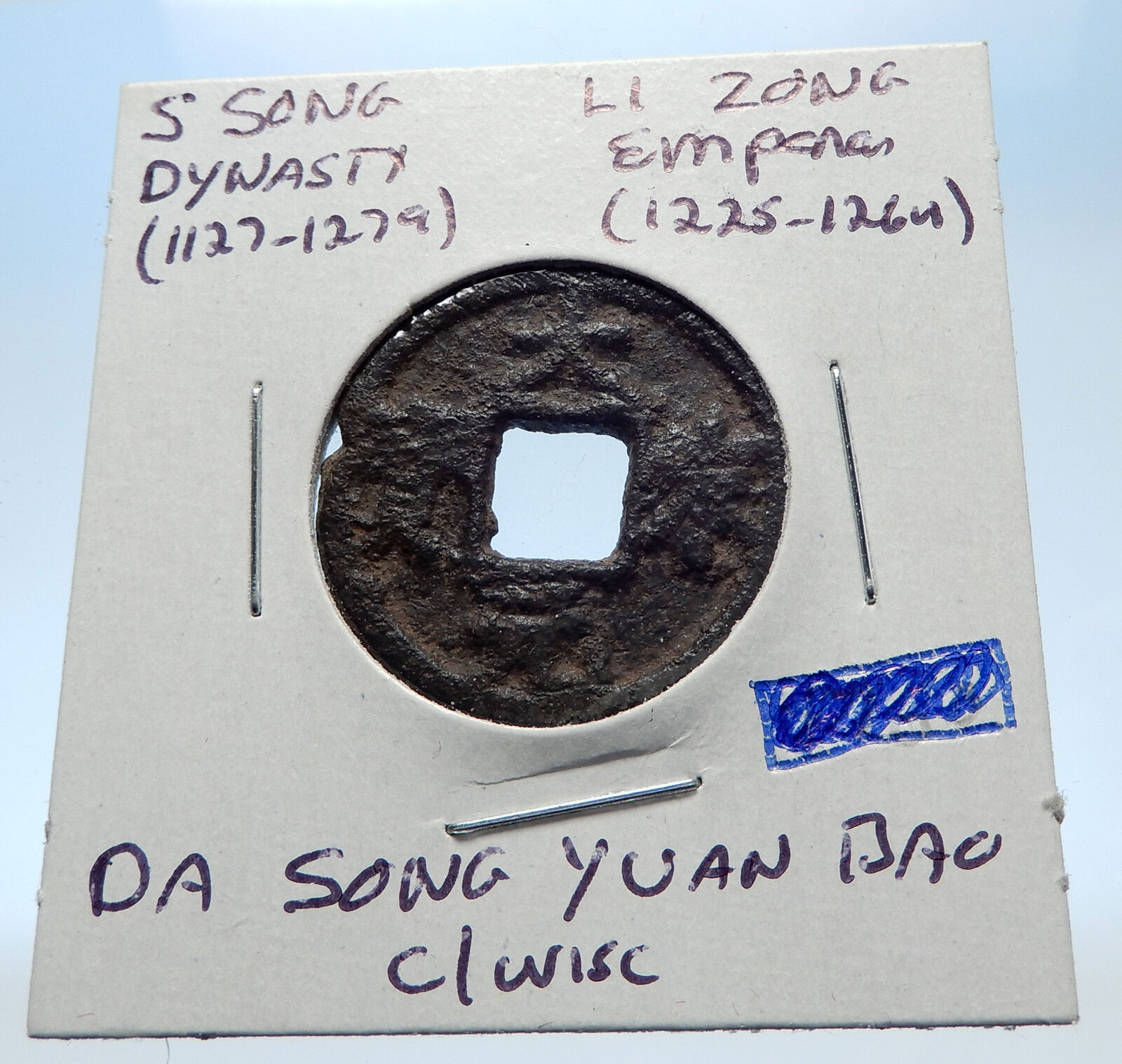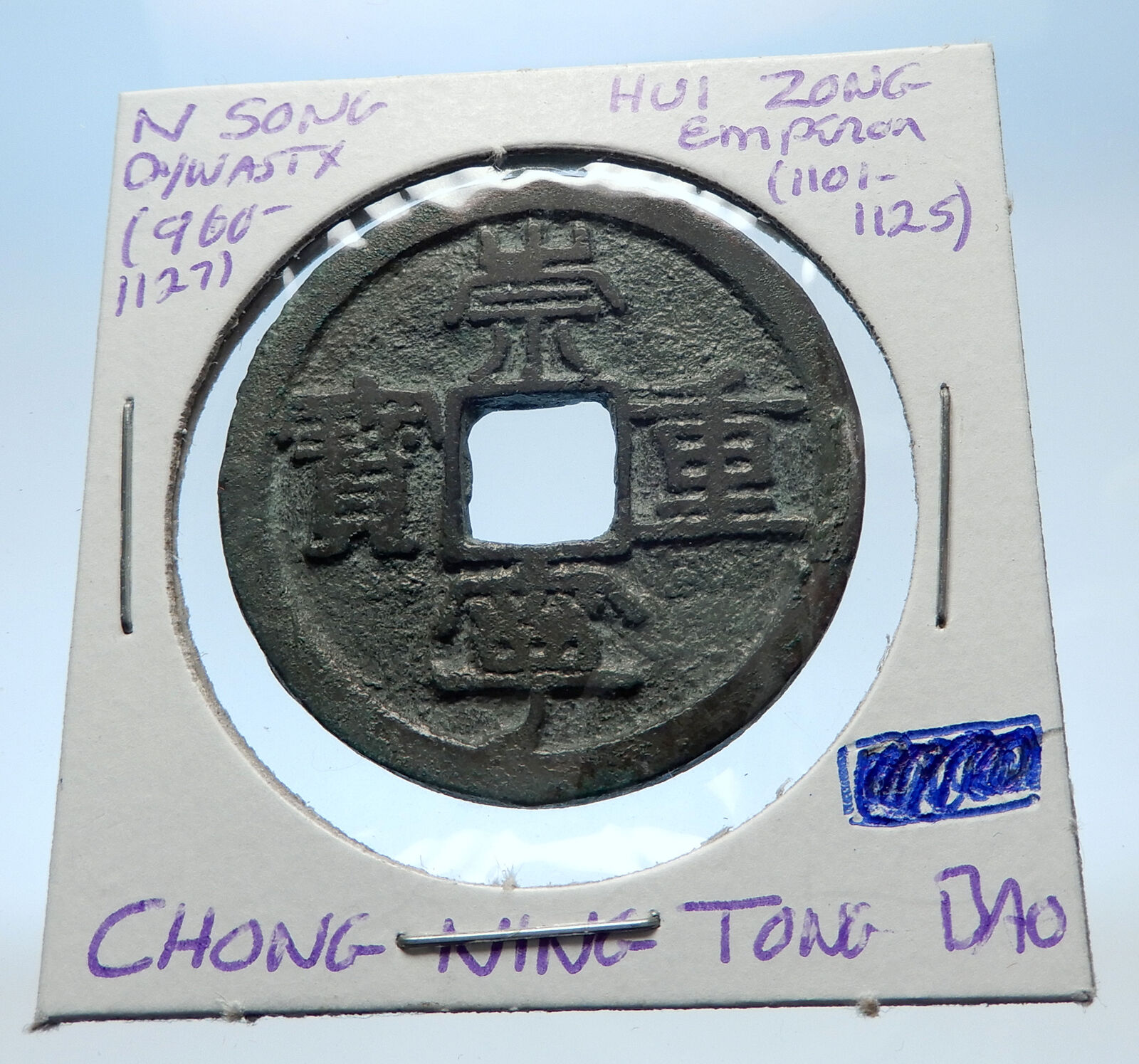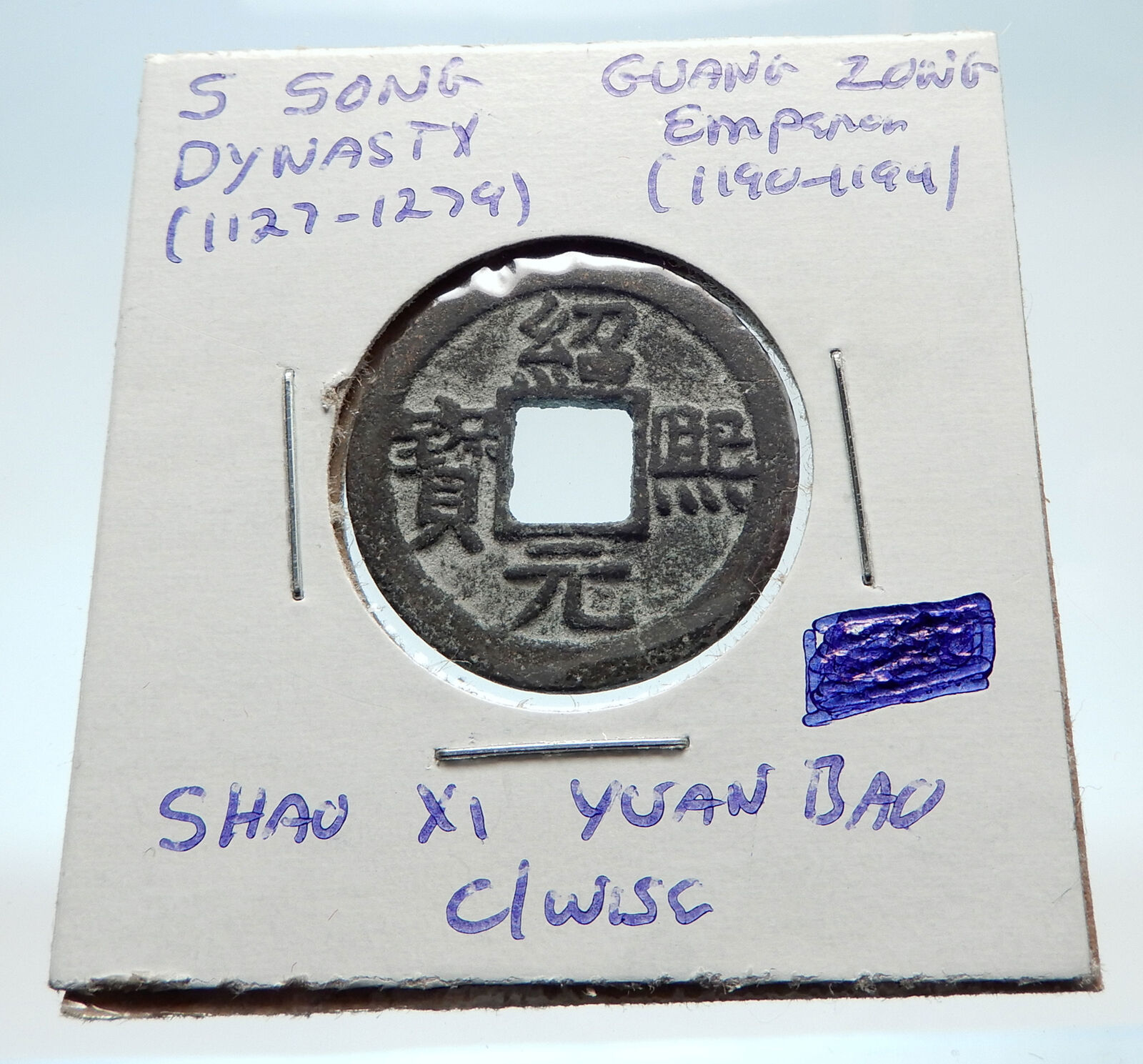|
China – Eastern Han Dynasty (25 – 220 AD)
Bronze Wu Zhu Cash Token 25mm, Struck 25-220 AD
Reference: H# 10.XA
Symbols.
Wang (King) below, four dots above.
You are bidding on the exact item pictured, provided with a Certificate of Authenticity and Lifetime Guarantee of Authenticity.
 The Eastern Han (traditional Chinese: 東漢; simplified Chinese: 东汉; pinyin: Dōnghàn), also known as the Later Han (traditional Chinese: 後漢; simplified Chinese: 后汉; pinyin: Hòuhàn), formally began on 5 August AD 25, when Liu Xiu became Emperor Guangwu of Han. During the widespread rebellion against Wang Mang, the state of Goguryeo was free to raid Han’s Korean commanderies; Han did not reaffirm its control over the region until AD 30. The Eastern Han (traditional Chinese: 東漢; simplified Chinese: 东汉; pinyin: Dōnghàn), also known as the Later Han (traditional Chinese: 後漢; simplified Chinese: 后汉; pinyin: Hòuhàn), formally began on 5 August AD 25, when Liu Xiu became Emperor Guangwu of Han. During the widespread rebellion against Wang Mang, the state of Goguryeo was free to raid Han’s Korean commanderies; Han did not reaffirm its control over the region until AD 30.
The Trưng Sisters of Vietnam rebelled against Han in AD 40. Their rebellion was crushed by Han general Ma Yuan (d. AD 49) in a campaign from AD 42–43. Wang Mang renewed hostilities against the Xiongnu, who were estranged from Han until their leader Bi (比), a rival claimant to the throne against his cousin Punu (蒲奴), submitted to Han as a tributary vassal in AD 50. This created two rival Xiongnu states: the Southern Xiongnu led by Bi, an ally of Han, and the Northern Xiongnu led by Punu, an enemy of Han.
During the turbulent reign of Wang Mang, China lost control over the Tarim Basin, which was conquered by the Northern Xiongnu in AD 63 and used as a base to invade the Hexi Corridor in Gansu. Dou Gu (d. 88 AD) defeated the Northern Xiongnu at the Battle of Yiwulu in AD 73, evicting them from Turpan and chasing them as far as Lake Barkol before establishing a garrison at Hami. After the new Protector General of the Western Regions Chen Mu (d. AD 75) was killed by allies of the Xiongnu in Karasahr and Kucha, the garrison at Hami was withdrawn.
At the Battle of Ikh Bayan in AD 89, Dou Xian (d. AD 92) defeated the Northern Xiongnu chanyu who then retreated into the Altai Mountains. After the Northern Xiongnu fled into the Ili River valley in AD 91, the nomadic Xianbei occupied the area from the borders of the Buyeo Kingdom in Manchuria to the Ili River of the Wusun people. The Xianbei reached their apogee under Tanshihuai (檀石槐) (d. AD 180), who consistently defeated Chinese armies. However, Tanshihuai’s confederation disintegrated after his death.
Ban Chao (d. AD 102) enlisted the aid of the Kushan Empire, occupying the area of modern India, Pakistan, Afghanistan, and Tajikistan, to subdue Kashgar and its ally Sogdiana. When a request by Kushan ruler Vima Kadphises (r. c. 90 – c. 100 AD) for a marriage alliance with the Han was rejected in AD 90, he sent his forces to Wakhan (Afghanistan) to attack Ban Chao. The conflict ended with the Kushans withdrawing because of lack of supplies. In AD 91, the office of Protector General of the Western Regions was reinstated when it was bestowed on Ban Chao.
Foreign travelers to Eastern-Han China include Buddhist monks who translated works into Chinese, such as An Shigao from Parthia, and Lokaksema from Kushan-era Gandhara, India. In addition to tributary relations with the Kushans, the Han Empire received gifts from the Parthian Empire, from a king in modern Burma, from a ruler in Japan, and initiated an unsuccessful mission to Daqin (Rome) in AD 97 with Gan Ying as emissary.
A Roman embassy of Emperor Marcus Aurelius (r. 161–180 AD) is recorded in the Weilüe and Hou Hanshu to have reached the court of Emperor Huan of Han (r. 146–168 AD) in AD 166, yet Rafe de Crespigny asserts that this was most likely a group of Roman merchants. In addition to Roman glasswares and coins found in China, Roman medallions from the reign of Antoninus Pius and his adopted son Marcus Aurelius have been found at Óc Eo in Vietnam. This was near the commandery of Rinan (also Jiaozhi) where Chinese sources claim the Romans first landed, as well as embassies from Tianzhu (in northern India) in the years 159 and 161. Óc Eo is also thought to be the port city “Cattigara” described by Ptolemy in his Geography (c. 150 AD) as lying east of the Golden Chersonese (Malay Peninsula) along the Magnus Sinus (i.e. Gulf of Thailand and South China Sea), where a Greek sailor had visited.
Emperor Zhang’s (r. 75–88 AD) reign came to be viewed by later Eastern Han scholars as the high point of the dynastic house. Subsequent reigns were increasingly marked by eunuch intervention in court politics and their involvement in the violent power struggles of the imperial consort clans. In 92 AD, with the aid of the eunuch Zheng Zhong (d. 107 AD), Emperor He (r. 88–105 AD) had Empress Dowager Dou (d. 97 AD) put under house arrest and her clan stripped of power. This was in revenge for Dou’s purging of the clan of his natural mother—Consort Liang—and then concealing her identity from him. After Emperor He’s death, his wife Empress Deng Sui (d. 121 AD) managed state affairs as the regent empress dowager during a turbulent financial crisis and widespread Qiang rebellion that lasted from 107 to 118 AD.
When Empress Dowager Deng died, Emperor An (r. 106–125 AD) was convinced by the accusations of the eunuchs Li Run (李閏) and Jiang Jing (江京) that Deng and her family had planned to depose him. An dismissed Deng’s clan members from office, exiled them and forced many to commit suicide. After An’s death, his wife, Empress Dowager Yan (d. 126 AD) placed the child Marquess of Beixiang on the throne in an attempt to retain power within her family. However, palace eunuch Sun Cheng (d. 132 AD) masterminded a successful overthrow of her regime to enthrone Emperor Shun of Han (r. 125–144 AD). Yan was placed under house arrest, her relatives were either killed or exiled, and her eunuch allies were slaughtered. The regent Liang Ji (d. 159 AD), brother of Empress Liang Na (d. 150 AD), had the brother-in-law of Consort Deng Mengnü (later empress) (d. 165 AD) killed after Deng Mengnü resisted Liang Ji’s attempts to control her. Afterward, Emperor Huan employed eunuchs to depose Liang Ji, who was then forced to commit suicide.
Students from the Imperial University organized a widespread student protest against the eunuchs of Emperor Huan’s court. Huan further alienated the bureaucracy when he initiated grandiose construction projects and hosted thousands of concubines in his harem at a time of economic crisis. Palace eunuchs imprisoned the official Li Ying (李膺) and his associates from the Imperial University on a dubious charge of treason. In 167 AD, the Grand Commandant Dou Wu (d. 168 AD) convinced his son-in-law, Emperor Huan, to release them. However the emperor permanently barred Li Ying and his associates from serving in office, marking the beginning of the Partisan Prohibitions.
Following Huan’s death, Dou Wu and the Grand Tutor Chen Fan (d. 168 AD) attempted a coup d’état against the eunuchs Hou Lan (d. 172 AD), Cao Jie (d. 181 AD), and Wang Fu (王甫). When the plot was uncovered, the eunuchs arrested Empress Dowager Dou (d. 172 AD) and Chen Fan. General Zhang Huan (張奐) favored the eunuchs. He and his troops confronted Dou Wu and his retainers at the palace gate where each side shouted accusations of treason against the other. When the retainers gradually deserted Dou Wu, he was forced to commit suicide.
Under Emperor Ling (r. 168–189 AD) the eunuchs had the partisan prohibitions renewed and expanded, while also auctioning off top government offices. Many affairs of state were entrusted to the eunuchs Zhao Zhong (d. 189 AD) and Zhang Rang (d. 189 AD) while Emperor Ling spent much of his time roleplaying with concubines and participating in military parades.
End of the Han dynasty
 The Partisan Prohibitions were repealed during the Yellow Turban Rebellion and Five Pecks of Rice Rebellion in 184 AD, largely because the court did not want to continue to alienate a significant portion of the gentry class who might otherwise join the rebellions. The Yellow Turbans and Five-Pecks-of-Rice adherents belonged to two different hierarchical Daoist religious societies led by faith healers Zhang Jue (d. 184 AD) and Zhang Lu (d. 216 AD), respectively. The Partisan Prohibitions were repealed during the Yellow Turban Rebellion and Five Pecks of Rice Rebellion in 184 AD, largely because the court did not want to continue to alienate a significant portion of the gentry class who might otherwise join the rebellions. The Yellow Turbans and Five-Pecks-of-Rice adherents belonged to two different hierarchical Daoist religious societies led by faith healers Zhang Jue (d. 184 AD) and Zhang Lu (d. 216 AD), respectively.
Zhang Lu’s rebellion, in modern northern Sichuan and southern Shaanxi, was not quelled until 215 AD. Zhang Jue’s massive rebellion across eight provinces was annihilated by Han forces within a year, however the following decades saw much smaller recurrent uprisings. Although the Yellow Turbans were defeated, many generals appointed during the crisis never disbanded their assembled militia forces and used these troops to amass power outside of the collapsing imperial authority.
General-in-Chief He Jin (d. 189 AD), half-brother to Empress He (d. 189 AD), plotted with Yuan Shao (d. 202 AD) to overthrow the eunuchs by having several generals march to the outskirts of the capital. There, in a written petition to Empress He, they demanded the eunuchs’ execution. After a period of hesitation, Empress He consented. When the eunuchs discovered this, however, they had her brother He Miao (何苗) rescind the order. The eunuchs assassinated He Jin on September 22, 189 AD.
Yuan Shao then besieged Luoyang’s Northern Palace while his brother Yuan Shu (d. 199 AD) besieged the Southern Palace. On September 25 both palaces were breached and approximately two thousand eunuchs were killed. Zhang Rang had previously fled with Emperor Shao (r. 189– AD) and his brother Liu Xie—the future Emperor Xian of Han (r. 189–220 AD). While being pursued by the Yuan brothers, Zhang committed suicide by jumping into the Yellow River.
General Dong Zhuo (d. 192 AD) found the young emperor and his brother wandering in the countryside. He escorted them safely back to the capital and was made Minister of Works, taking control of Luoyang and forcing Yuan Shao to flee. After Dong Zhuo demoted Emperor Shao and promoted his brother Liu Xie as Emperor Xian, Yuan Shao led a coalition of former officials and officers against Dong, who burned Luoyang to the ground and resettled the court at Chang’an in May 191 AD. Dong Zhuo later poisoned Emperor Shao.
Dong was killed by his adopted son Lü Bu (d. 198 AD) in a plot hatched by Wang Yun (d. 192 AD). Emperor Xian fled from Chang’an in 195 AD to the ruins of Luoyang. Xian was persuaded by Cao Cao (155–220 AD), then Governor of Yan Province in modern western Shandong and eastern Henan, to move the capital to Xuchang in 196 AD.
Yuan Shao challenged Cao Cao for control over the emperor. Yuan’s power was greatly diminished after Cao defeated him at the Battle of Guandu in 200 AD. After Yuan died, Cao killed Yuan Shao’s son Yuan Tan (173–205 AD), who had fought with his brothers over the family inheritance. His brothers Yuan Shang and Yuan Xi were killed in 207 AD by Gongsun Kang (d. 221 AD), who sent their heads to Cao Cao.
After Cao’s defeat at the naval Battle of Red Cliffs in 208 AD, China was divided into three spheres of influence, with Cao Cao dominating the north, Sun Quan (182–252 AD) dominating the south, and Liu Bei (161–223 AD) dominating the west. Cao Cao died in March 220 AD. By December his son Cao Pi (187–226 AD) had Emperor Xian relinquish the throne to him and is known posthumously as Emperor Wen of Wei. This formally ended the Han dynasty and initiated an age of conflict between three states: Cao Wei, Eastern Wu, and Shu Han.
Wu Zhu (Chinese: 五銖) is a type of Chinese cash coin produced from the Han dynasty in 118 BC when they replaced the earlier San Zhu (三銖; “Three Zhu”) cash coins, which had replaced the Ban Liang (半兩) cash coins a year prior, until they themselves were replaced by the Kaiyuan Tongbao (開元通寳) cash coins of the Tang dynasty in 621 AD. The name Wu Zhu literally means “five zhu” which is a measuring unit officially weighing about 4 grams however in reality the weights and sizes of Wu Zhu cash coins varied over the years. During the Han dynasty a very large quantity of Wu Zhu coins were cast but their production continued under subsequent dynasties until the Sui.
The production of Wu Zhu cash coins was briefly suspended by Wang Mang during the Xin dynasty but after the reestablishment of the Han dynasty, the production of Wu Zhu cash coins resumed, and continued to be manufactured long after the fall of the Eastern Han dynasty for another 500 years. Minting was definitively ended in 618 with the establishment of the Tang dynasty. Wu Zhu cash coins were cast from 118 BC to 618 AD having a span of 736 years, which is the longest for any coin in the history of the world.
Cash was a type of coin of China and East Asia, used from the 4th century BC until the 20th century AD. Originally cast during the Warring States period, these coins continued to be used for the entirety of Imperial China as well as under Mongol, and Manchu rule. The last Chinese cash coins were cast in the first year of the Republic of China. Generally most cash coins were made from copper or bronze alloys, with iron, lead, and zinc coins occasionally used less often throughout Chinese history. Rare silver and gold cash coins were also produced. During most of their production, cash coins were cast but, during the late Qing dynasty, machine-struck cash coins began to be made. As the cash coins produced over Chinese history were similar, thousand year old cash coins produced during the Northern Song dynasty continued to circulate as valid currency well into the early twentieth century.
In the modern era, these coins are considered to be Chinese “good luck coins”; they are hung on strings and round the necks of children, or over the beds of sick people. They hold a place in various superstitions, as well as Traditional Chinese medicine, and Feng shui. Currencies based on the Chinese cash coins include the Japanese mon, Korean mun, Ryukyuan mon, and Vietnamese văn.
|





 The Eastern Han (traditional Chinese: 東漢; simplified Chinese: 东汉; pinyin: Dōnghàn), also known as the Later Han (traditional Chinese: 後漢; simplified Chinese: 后汉; pinyin: Hòuhàn), formally began on 5 August AD 25, when Liu Xiu became Emperor Guangwu of Han. During the widespread rebellion against Wang Mang, the state of Goguryeo was free to raid Han’s Korean commanderies; Han did not reaffirm its control over the region until AD 30.
The Eastern Han (traditional Chinese: 東漢; simplified Chinese: 东汉; pinyin: Dōnghàn), also known as the Later Han (traditional Chinese: 後漢; simplified Chinese: 后汉; pinyin: Hòuhàn), formally began on 5 August AD 25, when Liu Xiu became Emperor Guangwu of Han. During the widespread rebellion against Wang Mang, the state of Goguryeo was free to raid Han’s Korean commanderies; Han did not reaffirm its control over the region until AD 30. The Partisan Prohibitions were repealed during the Yellow Turban Rebellion and Five Pecks of Rice Rebellion in 184 AD, largely because the court did not want to continue to alienate a significant portion of the gentry class who might otherwise join the rebellions. The Yellow Turbans and Five-Pecks-of-Rice adherents belonged to two different hierarchical Daoist religious societies led by faith healers Zhang Jue (d. 184 AD) and Zhang Lu (d. 216 AD), respectively.
The Partisan Prohibitions were repealed during the Yellow Turban Rebellion and Five Pecks of Rice Rebellion in 184 AD, largely because the court did not want to continue to alienate a significant portion of the gentry class who might otherwise join the rebellions. The Yellow Turbans and Five-Pecks-of-Rice adherents belonged to two different hierarchical Daoist religious societies led by faith healers Zhang Jue (d. 184 AD) and Zhang Lu (d. 216 AD), respectively.




